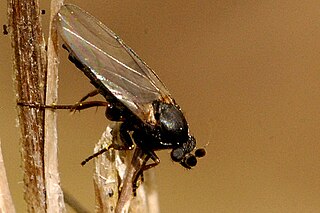
The Phoridae are a family of small, hump-backed flies resembling fruit flies. Phorid flies can often be identified by their escape habit of running rapidly across a surface rather than taking to the wing. This behaviour is a source of one of their alternate names, scuttle fly. Another vernacular name, coffin fly, refers to Conicera tibialis. About 4,000 species are known in 230 genera. The most well-known species is cosmopolitan Megaselia scalaris. At 0.4 mm in length, the world's smallest fly is the phorid Euryplatea nanaknihali.

The Metopininae are a subfamily of flies in the family Phoridae.

Anevrina is a genus of phorid flies circumscribed by the Italian naturalist Paolo Lioy in 1864.

Pseudacteon is a genus of flies in the family Phoridae. There are over 70 described species of Pseudacteon fly. They are also known as ant-decapitating flies due to their parasitic larval stage. An egg is injected by the female fly into the shoulder joint of an ant worker. Soon after, the egg undergoes rapid inflation as it appears to absorb ant hemolymph. This first instar larva migrates into the ant head and consumes the jaw muscle and other tissues, leaving the mandibles hanging and preparing a future exit space. After about two weeks, the ant worker is termed a "zombie" because the fly larva has effectively taken control. The worker leaves the nest and dies in the leaf litter or in a crack in the soil. As it dies, the ant's head falls off, apparently because the fly larva releases an enzyme that dissolves the membrane attaching the ant's head to its body. The fly pupates in the detached head capsule, requiring a further two weeks before emerging through the ant's mouth. In tropical, subtropical areas the flies are active all year round, but in temperate regions they are active during all months except the winter months. Several Pseudacteon species were deliberately introduced to the United States to combat via biological control the invasive fire ant species Solenopsis invicta.

Apocephalus is a genus of ant-decapitating flies. There are at least 300 described species in Apocephalus.
Beckerina is a genus of flies in the family Phoridae.

The Metopininae is a tribe of flies in the family Phoridae.
Chonocephalus is a genus of flies in the family Phoridae.
Cremersia is a genus of flies in the family Phoridae.
Diocophora is a genus of flies in the family Phoridae.
Menozziola is a genus of flies in the family Phoridae.
Metopina is a genus of flies in the family Phoridae.
Myrmosicarius is a genus of flies in the family Phoridae.
Neodohrniphora is a genus of flies in the family Phoridae.
Pericyclocera is a genus of flies in the family Phoridae.
Rhyncophoromyia is a genus of flies in the family Phoridae.
Xanionotum is a genus of flies in the family Phoridae.

Aenigmatias is a genus of flies in the family Phoridae.



